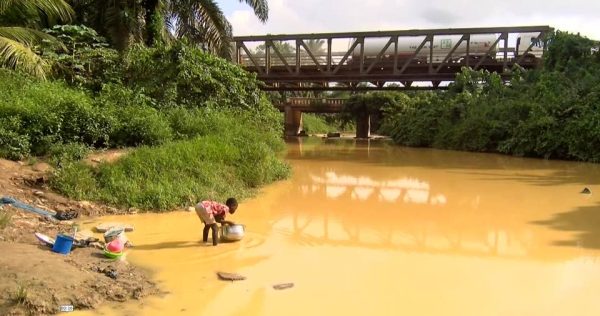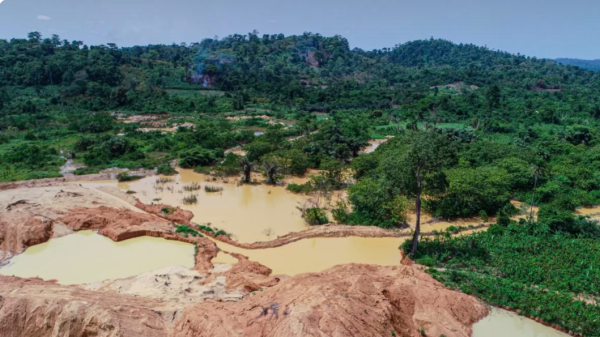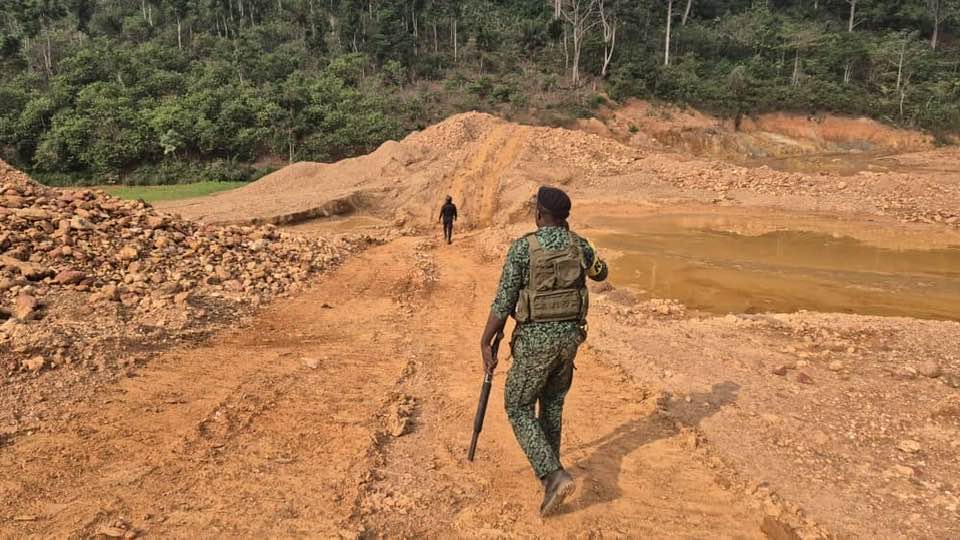Research shows that increasingly, more pregnant women are dying with their babies in and around the Bibiani-Anhwiaso-Bekwai and Dunkwa in the Western Region of Ghana where illegal mining is prevalent. Some of the babies, stored in jars as evidence at the Kwame Nkrumah University of Science and Technology in Kumasi in the Ashanti region of Ghana had six fingers, six toes, malformed heads and some having no genitals.
“One of the babies had his legs growing from the chest,” environmental journalist, Erastus Asare Donkor [1] of the Multimedia Group in Ghana, recounted from his engagement with Professor Paul Ossei Sampene of the Komfo Anokye Teaching Hospital. Research has established a link between deformities in babies and heavy metals from mining. This, however, is just one of the many implications of illegal mining on the health of people.
Illegal mining is also impacting farming, food production and livelihoods. It is destroying sources of potable water in a number of communities in mining areas in Ghana. “Today in Ghana, every major river or stream that I have come across, in the Western Region, Ashanti Region, Eastern Region, Upper East Region, even the Black Volta, has been contaminated and polluted by illegal mining. All farms located in these areas, that relied on these water sources for irrigation, for spraying of farms, have been affected,” Donkor revealed.

Illegal mining, also referred to as ‘galamsey’ in Ghana, is not only destroying arable lands and sources of drinking and farming water, it is also destroying settlements and killing people. Even though the laws of Ghana prohibit mining within settlements, illegal mining is happening in such places. “At Odumase [in the Ashanti Region], I have done reports where two people have died because of digging activities beneath homes … many of the houses there are sinking. One lady, who was pregnant, went to attend to nature’s call in her own home and the entire toilet sank into a galamsey pit,” Donkor narrated.
Unfortunately, any form of expression aimed at resisting and/or uncovering the activities of illegal mining and their harmful effects to communities and individuals is often suppressed. Environmentalists, community members, journalists and data collectors who raise alarm or come to the defence of vulnerable communities are attacked physically, emotionally and legally.
For example, when the degradation of the Apamprama (a community in the Ashanti Region) forest reserve started, illegal miners and their Chinese collaborators entered the Odaho section of the Apamprama forest reserve, the indigenes decided they would not allow the degradation to continue so they drove the Chinese miners out. “The illegal miners came together, got the support of some security operatives and well-built men, and mounted a road block at a section of the town, … accosted these people [the indigenes who chased the Chinese miners out] and subjected them to severe beatings. Some of them recounted their experiences to us and after the assault, many of them decided they would not fight it again and they left it. That part of the forest is now ruined, reduced to pits and gullies,” Donkor explained.

The indigenes of Atwima Mponua District have been in conflict with Chinese changfang (floating gold ore extractor) operators who are polluting the Offin River in the Western Region. The locals have raised concerns about the changfang operations, especially during the dry season. Feeling abandoned that their plight has been ignored by authorities, the natives decided to take their destiny into their own hands by trying to stop the changfang operations. This led to a confrontation with the Chinese operators. To their dismay, several of the locals found themselves arrested by the police. Some of them spent two or three days in cells before they were released, while the operators who were destroying their source of water were left untouched.

People have lost their right to free speech. Their right to quality air and water has been curtailed and the illegal mining menace is denying them of proper livelihoods and upkeep. Unfortunately, the perpetrators operate with total impunity, making environmental activism a lonely and daunting task. A number of these indigenes have migrated to urban areas in search for non-existing jobs.
Similar attacks are extended to the media workers who report on the destruction and degradation in the extractive sector. Media crew are attacked physically and sometimes held hostage; a reality that makes the stakes so high for budding journalists to venture into environmental journalism. “I was attacked, together with my crew … [The] miner was destroying a forest reserve. He claimed to have documents but when we pushed for it, he could not provide the documents, and rather held us hostage,” Donkor shared a personal experience.
The illegal miners often attack with boldness fuelled by the fact that their activities are backed by politicians and other powerful individuals with vested interest. In one instance, the official security assigned to halt illegal mining were disarmed by another set of security officials.
“When we reached the forest, we saw cabins erected and we saw genuine original military uniforms and even their weapons in those cabins in a forest being pillaged by an illegal miner. Within a few minutes, one military officer came to the place, he made some calls and then within thirty minutes, pickups full of fully-armed military men, as if they were going to war, stormed the place. We [Donkor and his crew] were held and detained by these people; they disarmed the government task force. They set free the Chinese miners [the government task force] had arrested and held us [Donkor and his crew] hostage. They detained us for five solid hours. When my driver tried to park our vehicle, he was subjected to severe punching on the face. They destroyed our vehicle’s windscreen and the side mirror,” Donkor narrated one of his ordeals in a reserve forest.

Donkor continued, “They wrestled with my camera technician for his camera, and in the end, they broke the camera. They said they wanted to destroy the footage we had taken of the place … They deleted the footage from our phones, including my child’s childhood photos. They forced us to delete footage from our camera.”
Such harrowing experiences deter many journalists from going into the hinterlands to get firsthand information which could serve as evidence for advocacy about the appalling environmental destructions and their implications. Indeed, the implications of the massive destruction of farmlands, water bodies and forests to health, food sovereignty and livelihood are too dire to be left unreported and unchecked.
Unfortunately, those with vested interests in the destruction of the environment keep on suppressing expression around these issues at the expense of the lives of entire communities. More needs to be done to protect and embolden the few environmentalists, communities and media people who brave the odds and risk their lives to stand up to illegal miners and report on the issues.
The government must, therefore, enable a freer environment for expression so environmental activists can boldly expose the destruction in the extractives sector to ensure that the livelihoods of small farm holders and their communities can be sustained. Perpetrators must also be made to face the full rigour of the law to discourage others from attacking community members and journalists.
This report is produced as part of the Media Foundation for West Africa (MFWA)’s project on Promoting Agroecology and Environmental Sustainability; and Enhancing Freedom of Expression in West Africa. The project, which is being implemented with funding support from the 11th Hour Project of the Schmidt Family Foundation, is aimed at promoting sustainable environmental and agricultural practices and enabling the environment for expression to ensure that unsustainable activities can be reported for redress.
[1] Erastus Asare Donkor is an award-winning environmental journalist working with the Multimedia Group Ltd in Ghana. He is known for his extensive reportage in the extractives sector which showcase the massive destruction in the sector. This article is largely informed by his experiences, observations and interviews with communities affected by illegal mining in Ghana.






